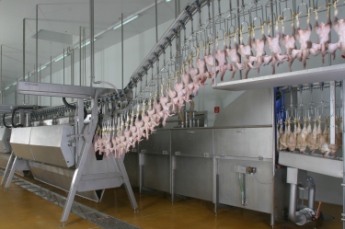Scalding and plucking for optimum carcass quality and yield

Scalding and plucking are very sensitive processes in a processing operation. As such, specific knowledge from plant and maintenance personnel is essential. Permanent care to secure the quality and yield of the carcasses and avoid the likelihood of defects that these processes may cause is required. This will avoid important economical losses.
By Fabio Nunes, poultry processing consultant, Curitiba, Brazil
The practice of scalding and plucking (picking) chicken carcasses to ease the removal of feathers is not new. It is a tradition from immemorial times when either domestic or wild fowls were processed in the back yard and used for in-house consumption. However, despite the vast advances in poultry processing machinery technology, the basic principles that rule both processes remain unaltered.
Described as such, the scalding and plucking of chicken carcasses may be understood by the ordinary consumer as something simple or even banal. However, the actual situation is totally different, as in both processes a large number of variables need to be properly harmonised and managed to produce feather- and defect- free carcasses at the end of the line.
Securing uniform position
Concerns about the performance of scalding and plucking must start far before the live broilers arrive at the processing plant, through the whole grow-out phase management so as to maximise the uniformity of grown birds. Once birds arrive at the plant, a well cared live hanging job to secure the uniform position of all feet onto the shackle will guarantee the consistent presentation of the carcasses to the subsequent process. Live hanging birds are then stunned and either hand or machine killed.
The killing must ensure the birds die from bleeding and not from the neck cutting itself. Slaughtered birds must bleed for a certain period of time, which is based on either country regulations or a company’s experience. The bleeding time must be long enough to prevent birds from entering the scalding tank either alive or gasping, but not too long for it to interfere negatively with the scald and plucking results. This can improve the performance and results of both processes.
Specific needs of plant
Carcass scalding is still carried out by immersion in hot water. However, developments like hot, humid air scalding, which has proven to be technically successful, yet commercially not, and even the futuristic microwave energy scalding, arise as very promising future alternatives for water-immersion tank, considering the benefits of water consumption, energy saving and cross-contamination reduction.
The scalding tank, which is not a one-size-fits-all piece of equipment, needs to be dimensioned and purchased according to the specific needs of each client and characteristics of each process. As such, the previous knowledge of the bird’s liveweight, line speed, skin colour of the final product and the breast fillet presentation are essential to determine its optimum physical specifications, which is responsible for the ideal combination of time x temperature, the ultimate binomials responsible for the success of the process.
Ruffling the feathers
The agitation of the water tank, by ruffling the feathers, enhances the heat transfer rate to the follicles, improving the scalding efficacy and smoothening the further plucking. Agitation is currently commonly carried out by the direct injection of air into the tank water, provided by one or two external blowing pumps connected to nozzles installed lengthwise at the bottom of the tank. The air bubbling lowers the water density, causing the carcasses to sink, while simultaneously ruffling the feathers, enhancing the heat transfer to the follicles.
| Proper scalding and plucking must produce feather- and damage-free carcasses. | Improving the cleanliness of scalding water contributes to reduce cross-contamination and improves product hygiene. |
The blowing pack has low energy consumption and demands a simple periodical maintenance thanks to its simple construction. More recently an equipment manufacturer, by combining the principles of the water cascade with the air injection, came up with the novel technology of pressurised water. Innovative in concept, simpler in construction and more efficient compared to its ancestor, the pressurised water technology provides an improved heat transfer rate and secures a more uniform scalding whilst demanding lower energy.
Yellow or white skin
Carcass scalding can be either soft – 55°C, for around 2 to 3 minutes to produce yellow-skinned birds – or hard – 57°C upwards for around 2 minutes for production of white-skinned birds. Water heating can be achieved by direct heating, by injecting steam into water; indirect heating, by using a steam or thermal fluid heated-coil, or even using pre-heated water generated either inside or outside the scalding room. The water heating and its homogeneity inside the tank during operation hours plays a decisive role in guaranteeing the efficacy of the process. In addition, the amount of heat absorbed by the follicles is ultimately responsible for the ease or difficulty in the later removal of feathers and, as importantly, for the preservation of the breast fillet presentation and the subcutaneous fat layer integrity.
Scald-burnt breast fillet is a problem in some markets although in some others it is not. However, the liquation of the subcutaneous fat layer, thanks to improper time x temperature, is a real economical problem for companies by giving its impact on the carcass yield – draining down from 0.5% to 1.5% of the carcass’ weight. Let’s consider the liquation of skin fat in a plant running 100,000 birds per day, 2.5 kg live weight:
100,000 x 2.5 Kg = 250,000 Kg/day
Scalders can have a two- or multi-pass line set up, housed by single-, double- or even triple-stage configuration. The two-pass tank is the most common configuration. Sometimes long, it allows, advantageously, for the full visual control of what is going on inside, while permitting ease of access to the carcass in case of a problem or power outage and for sanitation and maintenance, as well. Triple- or quadruple-pass set ups, yet less common, are also seen. More compact than its double-pass counterpart, they are the choice when the equipment needs to be adapted to an existing scalding room.
Scalded carcasses must be promptly picked. To avoid cooling down upon leaving the tank, the overhead conveyor in between the tank exit and the first picker must be the straightest and shortest possible. In case it defers from this recommendation, the company should consider placing a tunnel around the line, connecting the tank to the picker to prevent the heat from dissipating to the environment.
Rubber fingers of superior quality, often priced above the average ones, are more durable and withstand the warm water better, therefore deliver a better job while offering a more attractive cost versus benefit relationship than average rubber fingers. The setting of the rubber fingers in the picking machine varies among companies. Some choose a single hardness for all machines, while others opt to work with a specific hardness per picker.
| Checking fingers and replacing worn, broken or missing ones is decisive to improving picking efficacy. | Closed scalding tank contributes to saving energy. |
The decision about what to do and what is best depends upon the operator’s experience and watchfulness. Fingers must be revised every day and worn out, broken or missing ones must be readily replaced. Be aware of the fact that saving on finger replacement may prove to be more costly in the long run, considering that pickers running damaged or missing fingers are more likely to inflict damages to the carcasses. Keep records of finger replacement for reference about process performance and supplier dependability.
Picking machines are dynamic beings and, as such, must be constantly adjusted to the physical characteristics of the flock in process. This dynamic delivers a more precise work, contributing for a smoother job and to lesser damages to the carcasses. Picking machines must be equipped with feet guide bars to avoid the leg being unhung during the process, dislocating from the hip joint and/or tearing the skin, and preventing the carcass from falling down on the feathers flume.












